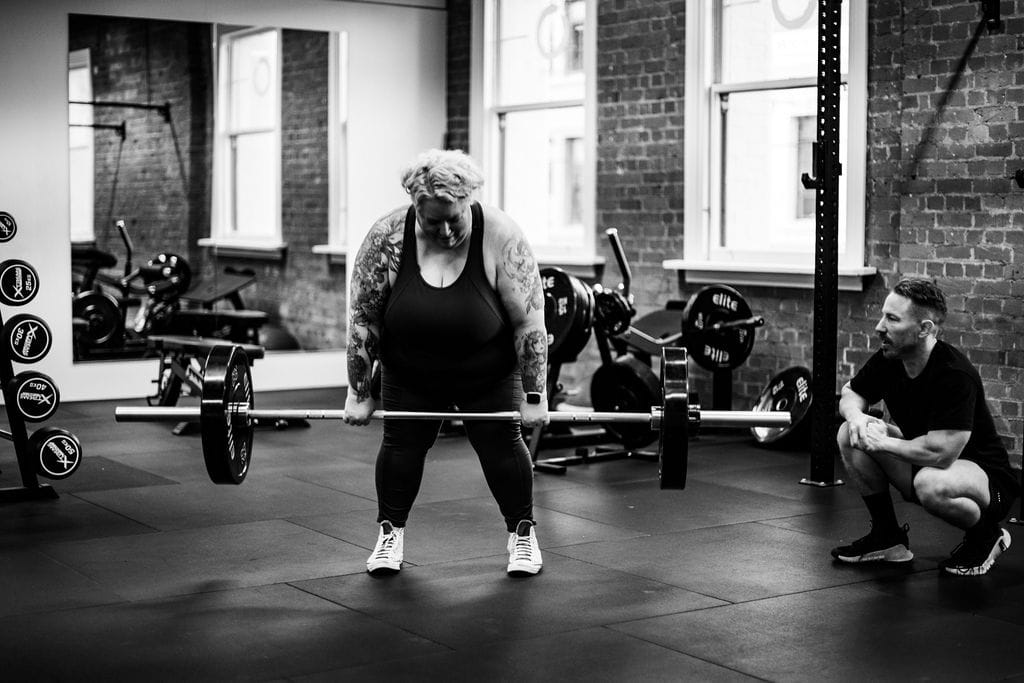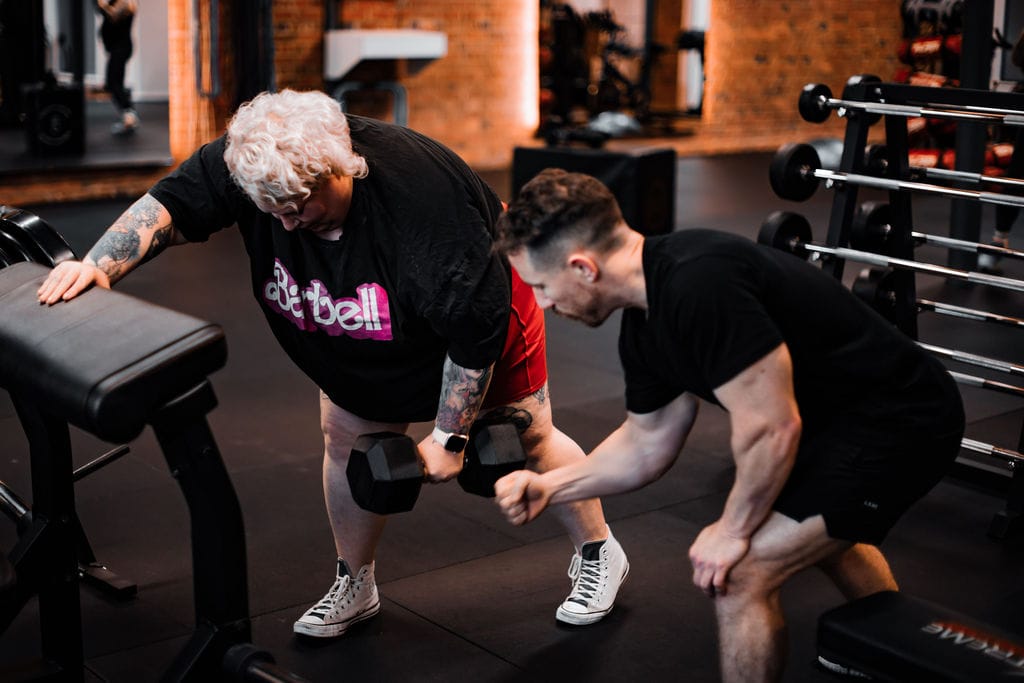Seriously, where the #$^& are my lats?

“Engage your core, and breathe,” the Pilates instructor says in that smooth, deep tone they all seem to have—a tone I’m fairly certain is genetic and comes bundled with their superhuman flexibility.
Meanwhile, I’m on the reformer, entire muscle groups quivering with effort, trying to figure out how I’m supposed to both engage my core and breathe at the same time.
I’m sucking in my stomach, trying to get my belly button to touch my spine, lifting my pelvic floor, and, I don’t know, maybe also rubbing my stomach and patting my head. And somehow I’m also supposed to breathe through all of that? How?
How on earth am I supposed to suck in my stomach and breathe at the same time?
It reminds me of the first time a trainer—wonderful, incredible Nell—said, “Engage your glutes,” and I thought to myself (and maybe out loud), Mate, I don’t even know which ones my glutes are.
Logically, sure, I knew where my glutes were. But “engaging” them? Did that mean squeeze them? Flex them? Think about them really hard and hope for the best?
I wish I could tell you I found some secret trick for activating them. But the truth? I just did thousands of deadlifts in every variation imaginable. And eventually, I figured it out. I learned what it felt like to use my glutes—not my lower back, not my quads, not whatever muscle decided to step in that day.
I also plucked up the courage to, you know, ask. And Nell helped, pretty much exactly as Carl explains below.
And that learning process didn’t just change how I trained. It changed how I live in my body.
Before, my body was this blurry, inconvenient thing that started somewhere below my neck and mostly existed to be critiqued or ignored. It was something to manage, not something to inhabit. And I was doing a pretty bad job of managing it. I had absorbed—through media, culture, family, lovers—that if I thought about my body at all, it should only be in the context of making it smaller. But to want to do so was, of course, deeply shallow.
Now, all those deadlifts later, I know I’m getting sick because I can feel it in my body. I know when I haven’t recovered well because of a particular heaviness in my legs when I climb stairs. When I’m carrying groceries, I think, More shoulder, Megan, and the bag gets just a bit easier to hold. I know when my deadlift form is good because I can feel which muscles are creating and holding the tension.

Lifting weights didn’t just change my relationship with my body—it gave me one. The mind-muscle connection isn’t just real—it’s deeply cool. I went to pilates this week, and when the instructor said "use your rhomboids," I could focus on those muscles. Focus, if not actually pull myself up with them.
But before I hand over to Carl, a confession.
I can absolutely engage my glutes now. Most days, my core and I are about to be wed. But my lats? Half the time, at best.
So, Carl, when you’re telling me to “engage my lats,” what the hell do you mean?
Thanks Megan, I love neuromuscular physiology (it really gets me going!), and there are a few things to flesh out here…
First up: the experience you're describing is often referred to by gym bros as the “mind–muscle connection”, and in exercise physiology as neuromuscular activation.
When you consciously think about a muscle during movement, your brain increases neural drive to the motor units (nerve–muscle bundles) that control it. The more motor units recruited, the more muscle “activation” you get. It’s kind of like shining a spotlight on one muscle instead of spreading your attention across many.
There’s a saying: “Nerves that fire together, wire together.” The more often you connect your mind to a specific muscle, the more efficient and automatic that connection becomes. That’s how Megan can now party-trick her glutes! This principle also applies to thoughts, feelings, cognition—anything involving the nervous system. And, just like with those, awareness is the first step to change.
Directing focus to a specific muscle during a lift can improve coordination, strength, and hypertrophy of that muscle. For example, EMG studies on the bench press show that simply shifting your focus to your pecs versus your triceps changes which one gets more activation.
Take the single-arm dumbbell row: if you just think about moving the weight from point A to point B, you’ll get fairly even contribution from several muscles—like the lats, rhomboids, obliques, and traps.
But if your goal is to target your lats, and you have good awareness of that muscle, you can consciously shift more of the workload to them. That increased activation not only boosts your results—it strengthens your mind–muscle connection over time.
Of course, this can be both a good and a not-so-good thing. It builds awareness, but it can also reinforce dominant patterns or overactive muscles.
So, how do you build the mind–muscle connection?
The first step is simple—but often skipped: do you actually know where the muscle is? Look it up—find an image and understand where it attaches. Visualising where it sits and how it moves will make it easier to feel it during your training.
It helps to start with more isolated movements—say, a lat pulldown to target your lats—before progressing to more complicated lifts like a single-arm row. A trainer can help you choose the right movements and offer cues to support better activation.

Cueing is powerful. A great one for lats during a pulldown is to think about pulling through your elbows. Tactile feedback can also help—either from a trainer tapping the muscle (with consent), or you using your hand to lightly press or tap the area.
In summary:Research the muscle. Visualise it. Isolate it. Touch it. Tap it. And if you can, get yourself a coach to guide your exercise selection and cue you properly.
Happy activating, fam!
Cool things we saw this week:
(Carl)Coffee consumption and reduction in all cause mortality Meta Analysis of 40 studies. Lowest relative risk was at 3.5 cups per day. It seems as if this applies if the coffee is consumed before midday. Study here Discussion here with Dr Rhonda Patrick
(Carl) Have teens that think they know everything? (I do! lol.) The prefrontal cortex, responsible for higher-level cognitive functions like planning, decision-making, and impulse control, undergoes significant development throughout childhood and adolescence, but doesn't fully mature and develop well into the 20’s. So can we blame them/ourselves for silly decisions?
(Megan) I wear both an Apple Watch and an Oura Ring, so I clicked on this link with some trepidation, but it's pretty good, actually.
(Megan) I would love to talk to Lorde (or really anyone who will listen) about this "dark fitness culture" she sees. I am never more happy than when women talk about feeling physically strong. (Also, reacting to that fitness culture is exactly what Carl and I are trying to do here. In a positive way.)
(Megan) More on wearable devices: "There is an assumption in these presentations that life in contemporary society is moving so fast that it is nearly impossible to trust one’s senses and experiences. The body, as it seems, is simply too slow to keep up with an increasingly accelerating society, and needs technological assistance to keep track of how it reacts to its surroundings.”
(Megan) If you liked last week's link about the England Roses nutrition/protein meals, BBC Food's insta has some how to videos. I had this smoothie after the gym last weekend and it was fab.
That's all for this week, thank you for reading! If you have feedback please email Megan, or if there's anything you would like us to consider writing about.
